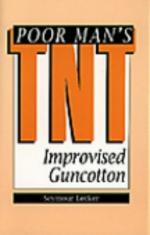|
This section contains 307 words (approx. 2 pages at 300 words per page) |
Guncotton, discovered in 1845 by Christian Friedrich Schönbein, a German chemist, represented a new phase in explosive weaponry. Previously, black gunpowder was used in great amounts for all weapons. The disadvantage was that it tended to give off large clouds of black smoke, obscuring the battlefield. Guncotton, on the other hand, was nearly smokeless. It was also extremely unstable: a sharp blow could make dry guncotton explode. Even wet guncotton, though more stable, could explode. Schönbein discovered guncotton when he was experimenting with nitric and sulfuric acids in the kitchen, an activity that did not meet with his wife's approval. He spilled the acids and mopped them up with his wife's cotton apron, then hung the apron above the stove to dry. Once dry, the apron burst into flames. Schönbein researched the phenomenon and discovered that the nitric acid had bonded with the cellulose in the cotton to form nitrocellulose. Schönbein did not reveal his method of production until 1846 when Boettger and Nikolas August Otto also discovered it. Schönbein placed cotton into fuming nitric and sulfuric acids, boiling the guncotton to remove impurities and any remaining acids, grounding it into a fine powder, draining it, and letting dry into slabs. Explosions in the production plants often interrupted the process; many people were killed by guncotton before it ever reached the battlefields. Eventually, James Dewar and Frederick Abel were able to make the guncotton more stable and used it to produce the first smokeless gunpowder, called cordite. Cordite eventually inherited many of guncotton's uses, just as guncotton had replaced black gunpowder. Schönbein, meanwhile, developed collodion, a viscous mixture of guncotton and ether, which was more stable than ordinary guncotton. Collodion also had medicinal and photographic applications. Full-scale production of guncotton stopped in the early 1860s.
|
This section contains 307 words (approx. 2 pages at 300 words per page) |


